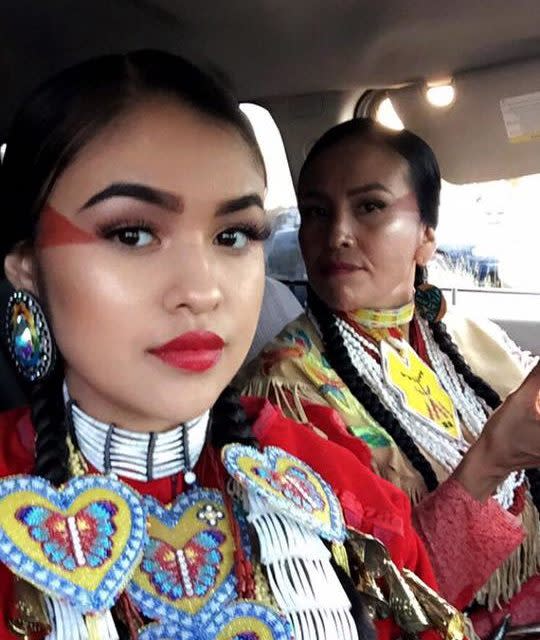This Cree dancer organized a red dress jingle dance to remember missing and murdered indigenous women
Every year, Gathering of Nations Powwow brings together thousands of Native American and First Nations singers, dancers, and drummers from all over the U.S. and Canada for the largest powwow in the world. At this year’s event, 17-year-old jingle dancer Tia Wood of Saddle Lake Cree Nation, Alberta used her role as head young lady dancer to bring attention to the over 1,000 missing and murdered indigenous women in the United States and Canada.
Prior to Wood’s tribute, in 2014, Métis artist Jaime Black created the installation piece The REDress Project. For that project, Black collected over 600 red dresses, which were installed in public spaces across Canada to draw attention to the high number of missing and murdered indigenous women. Inspired by that project, Wood called for dancers to wear red dresses to participate in a special old-style jingle dance at this year’s Gathering of Nations.
The result was stunning, as this video shows:
Healing Dance for Missing and Murdered Indigenous Women
Posted by Natalie Nicotine on Friday, April 28, 2017
The jingle dance is performed by female dancers wearing dresses covered in small metal cones — these make the “jingle” sound that gives the dance its name. It is said that the dance was brought to the Ojibwe people during the Spanish flu epidemic in the early 1900s, a time when Native dancing, among other cultural practices, was banned by the government.
According to certain accounts, the dance was brought to life when a father sought help from a medicine man for his ailing daughter. This man had a vision of the dress and the steps of the dance, which in its original style (called “old style” now) had dancers keep their footwork light and close to the ground, never crossing their feet or dancing backward. (The modern style jingle dance incorporates much more movement.)
#Reddress
Posted by Ontaria Arrow White on Wednesday, March 29, 2017
Today, the jingle dance is a popular competition dance at powwows, but it is always regarded as a healing dance. Wood herself knows about healing. Five years ago, a car wreck left her with such severe injuries that doctors were unsure she would walk again, much less dance. The jingle dance’s origin as a healing dance is one reason Wood chose it.
“Native women are placed at the bottom of society with really no power. I want to help restore Indigenous women to places of honor,” Wood said in a CBC News interview.
Tia Wood Red Jingle dress special top 10!
Posted by Gathering of Nations Powwow on Friday, April 28, 2017
Immediately after the dance, Wood, who comes from a family of singers and dancers, wrote on her Facebook page, “this was such a dream come true to witness all these red dresses and energy

❤
I’ve always dreamt of putting this special on and I did. I’m sooo grateful I got this opportunity. Aiyhiy. In honour of the missing and murdered indigenous women.”
my momma
️
Posted by Tia Wood on Sunday, October 23, 2016
As lawyers, tribal members, and families continue to advocate and work for justice, Wood hopes the dance will help heal those devastated by violence against indigenous women, as it has healed indigenous people for generations.


